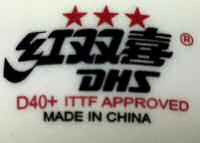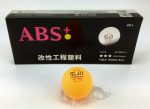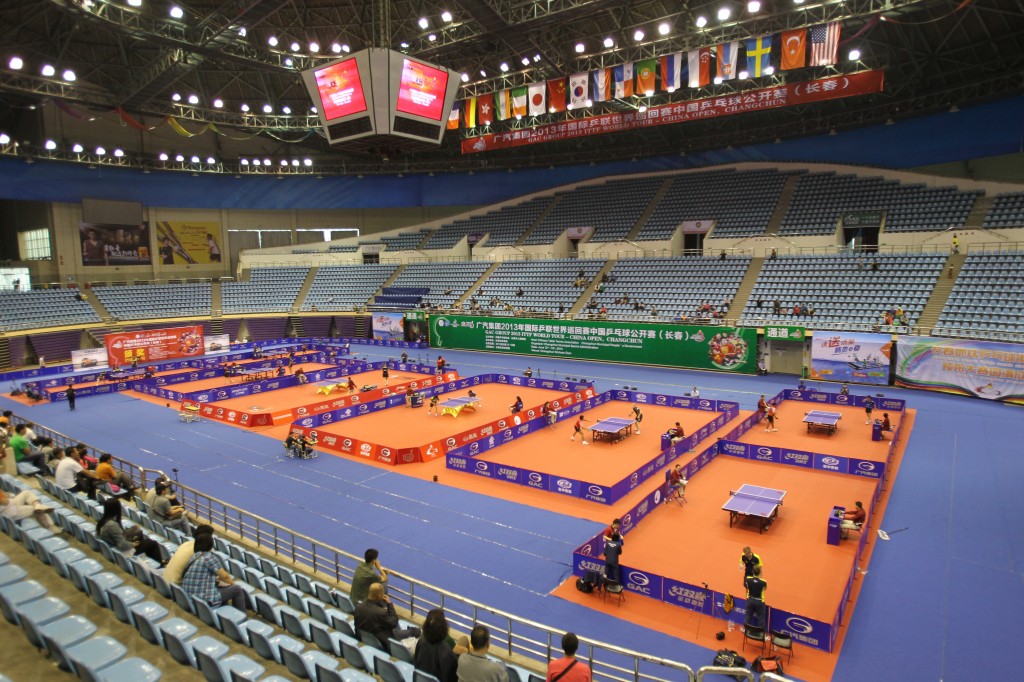
Plastic table tennis balls became legal for competition in 2014. Although the old celluloid balls remained legal as well, manufacturers quickly saw the writing on the wall, and started phasing out celluloid balls. As well as a change from celluloid to plastic, the ITTF imposed a requirement (with no apparent player consultation nor a vote!) on the manufacturers that the ITTF approved plastic balls also needed to be a minimum of 40mm, whereas the old tolerance for celluloid was 39.5 to 40.5mm. Typically the celluloid balls measure around 39.6 to 39.7mm, whereas the new plastic balls measure around 40.2mm, so as a result we’ve got balls that are around 0.5mm bigger. This increase in size, as well as the change of material generally means balls are slower and less spinny, and do also bounce and grip differently on the table and have a different trajectory.
While I personally have no problem with the introduction of plastic balls, I find it completely unacceptable that the ITTF mandated a new tolerance resulting in bigger balls. Similarly I find it unprofessional of the ITTF to mandate the use of the new plastic balls for international events, before the balls were made to a acceptable standard. I’ll leave that for another article :).
The early plastic balls were very different from celluloid balls, and were mostly also fragile and produced some rather spectacular breakages at times, which I’m sure many of you remember. As time went on, manufacturing processes improved, as demanded by players and organisations worldwide, and the balls became less fragile and more durable, although the cost and durability were still significantly worse compared to the old celluloid balls. The financial impact put pressure particularly on the smaller clubs, who were already experiencing spiralling electricity and insurance costs, so the pressure on manufacturers to reduce cost and improve durability remained.
The great majority of competition balls are produced by only a handful of manufacturers, and most of the brands buy from one of these manufacturers and get them tweaked to their own specification and rebadged with their own brand. As a result, there are really only a few different types of balls, the others being basically rebadged versions from the same manufacturer.
Until recently most of the plastic balls were made of a plastic called “Cellulose Acetate”. However a new type of ball, using a material called “ABS” (acrylonitrile butadiene styrene) came into the market, which has proved to be significantly more durable, produce a bounce closer to the old celluloid, while most importantly is also significantly cheaper. While this is certainly another step in the right direction, particularly the lower cost and better durability, the characteristics of these balls are a little different to both the original celluloid and the plastic balls that most associations around the world have been using.
Many clubs in Australia have been using the DHS 40+ balls since 2015, which is a “Cellulose Acetate” ball. This ball was chosen because it was the same ball used by many of the National (as well as International) events, so using the same ball greatly helps prepare our players that participate in these events. The breakage rate was high in the early days, but improved significantly over the years.
 DHS is the biggest manufacturer of competition balls worldwide, and in early 2017 DHS released their new ABS plastic ball called the DHS D40+ table tennis balls. Most reports so far indicate that these balls are indeed much more durable, have a good bounce like celluloid, and they are indeed significantly less expensive. Since DHS is a major sponsor of ITTF events, it wasn’t long before the ITTF announced the DHS D40+ would be the official ball for new events;
DHS is the biggest manufacturer of competition balls worldwide, and in early 2017 DHS released their new ABS plastic ball called the DHS D40+ table tennis balls. Most reports so far indicate that these balls are indeed much more durable, have a good bounce like celluloid, and they are indeed significantly less expensive. Since DHS is a major sponsor of ITTF events, it wasn’t long before the ITTF announced the DHS D40+ would be the official ball for new events;
Commencing in Korea, new DHS Plastic Ball to be used at all ITTF World Tour and Challenge tournaments 21 Mar 2017
Beginning with the Seamaster ITTF World Tour Korea Open; for which the qualification competition commences on Tuesday 18th April, all ITTF World Tour events and all ITTF Challenge tournaments for the rest of the year will be played using the new DHS Plastic Ball (DHS D40+***).
The 2017 ITTF Challenge Thailand Open to be staged in Bangkok with the preliminary stages scheduled to start on Wednesday 29th March will be played using the current DHS 40+*** ball. The Seamaster 2017 ITTF World Tour Korea Open will witness the first use of the new DHS Plastic Ball.
Events for which a Prospectus has been issued and will now use the new DHS Plastic Ball (DHS D40+***) ball are:
-
Seamaster ITTF World Tour Korea Open
-
ITTF Challenge Seamaster Chile Open
-
ITTF Challenge Slovenia Open
-
ITTF Challenge Croatia Open
-
ITTF Challenge Seamaster Brazil Open
It wasn’t long after DHS announcement of their new ball, that other brands also announced a new type of ball, which are presumably of a the same or similar material, with similar (but not always identical) performance.
It’s very likely that the DHS 40+ will be discontinued and replaced by the new D40+, which are now widely available. Similarly other manufacturers will likely discontinue their older balls and change to the new cheaper & more durable balls.
The seamless plastic balls continue to be made and popular among a smaller but significant number of players & clubs. Technically these balls are superior to the current ABS variant of balls because they have no seam. Although these balls are also high durable and cost effective, as far as we know these balls are made by a single and smaller manufacturer (with several other brands released their tweaked & rebadged version made in the same factory), so they probably won’t have the capacity nor capital to sponsor major events. Although the bounce and durability of these balls is very good, many players feel that these are also the least spinny of the plastic balls, which affects their popularity.
 What about orange 3* plastic balls? As of the time of writing, there are still no orange 3* balls on the ITTF approved list, so they are probably still some time away. It is likely that manufacturers have spent most of their resources in developing better balls and reducing costs, and since the official ball is still white, orange are not a priority. However a few orange training balls (1*) are starting to come into the market, as well as some 3* non-ITTF approved orange ABS balls, so it’s likely we’ll have some 3* within a year… that’s my prediction.
What about orange 3* plastic balls? As of the time of writing, there are still no orange 3* balls on the ITTF approved list, so they are probably still some time away. It is likely that manufacturers have spent most of their resources in developing better balls and reducing costs, and since the official ball is still white, orange are not a priority. However a few orange training balls (1*) are starting to come into the market, as well as some 3* non-ITTF approved orange ABS balls, so it’s likely we’ll have some 3* within a year… that’s my prediction.
Check out OOAK Table Tennis Shop for these table tennis balls and others.


Hello,could you compare these balls to the new Nittaku 3* PREMIUM balls please ?
Thank you